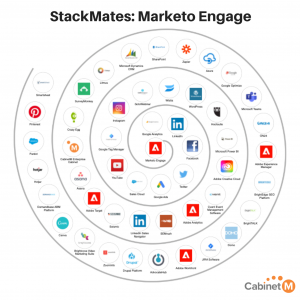Microsites used to be a very popular tool a couple of years back, but got a very bad rep because microsites were heavily abused by black-hat SEO folks, who used them to set up private blog networks and artificially create backlinks to content.
However, microsites are still a very powerful tool and used in a the right setting, will provide you with many benefits. A question I get regularly when talking about microsites is how they are different from their cousin ‘ the landing page.
The article here will give you a solid overview of the differences between them and when to use which.
Let’s get started with defining what exactly a microsite and a landing page is.
Definition of a microsite
On the Readz site, we find a microsite definition that is more up-to-date than most other descriptions, which keep on referring to the (improper) use by black-hat SEOs:
A microsite is a smaller, simpler auxiliary site that is different from a company’s main website, serves a specific purpose and is usually temporary. Some have their own domain names, while others live happily on a brand’s main site.

An example of a great microsite: Procter & Gamble’s Being Girl
Definition of a landing page
A landing page, on the other hand, is defined as such: In its simplest form, a landing page is any page on the web in which a visitor can “land.”
However, this can confuse people into believing that all pages on the web are landing pages, which is not true. While all landing pages are web pages, not all web pages are landing pages. Make sense? Let’s continue.
Unbounce describes a landing page as such:
“When discussing landing pages within the realm of marketing and advertising, it’s more common to refer to a landing page as being a standalone web page distinct from your main website that has been designed for a single focused objective.”
Sounds a lot like a microsite, but there’s more… “This means that your landing page should have no global navigation to tie it to your primary website. The main reason for this is to limit the options available to your visitors, helping to guide them toward your intended conversion goal.”

Here is an example of a SalesForce landing page
A deeper look into the difference between a microsite and a landing page
In terms of their similarities, they are both extensions of your main website, focused on one particular campaign or purpose, and both can have SEO benefits. But the similarities end there.
Landing Pages Use
In a nutshell, landing pages don’t mess around; they get right down to business. They are meant for visitors who are ready to take action and ready to buy. Karo Kilfeather writes in a blog post, “Landing pages provide a controlled, testing-friendly environment where there is a clear indicator of effectiveness: Someone either clicked the button or did not” (Percussion).
Landing page pros
- Hyper-focused message designed around call to action
- Easy to test effectiveness with fewer page elements and A/B testing
Landing page cons
- Low engagement due to hyper-focused content
- Can be a huge turn off to visitors if viewed at wrong buying stage
- Continuity with main site design can be restrictive
Microsites Use
Microsites are more about the content. You are providing a solution to your visitors’ problem. Microsites work great in the awareness stage of the buyer’s cycle. You can still have a call to action (and it will be clearer than it might be on your main website), but ultimately, landing pages are best for that immediacy. However, microsites are invaluable in that they build trust and keep your visitors coming back for more because of it.
Micro site pros
- Stronger content focus and stronger message for campaigns
- Opportunity for high engagement levels
- More flexibility with content and design
- Higher SEO benefit
Microsite cons
- More content needed
- Call to action not as explicit as with landing pages
- Potential abuse of design flexibility and confusion of brand identity
When To Use Which
You’ll want to use a landing page solely for the purpose of collecting visitors’ information.
You can do this through a lead capture form (like in the above example). Visitors can find this landing page through search engine optimized search results, social media, email, a QR code or an online advertisement. Some common uses for landing pages are promotional offers, free trials, product sales, sign-up sheets (for special events or newsletters), and (gated) free content. Remember, the goal of a landing page is to convert site visitors into leads.
A landing page will typically act as a gate. Use a microsite for a specific purpose, like launching a product, campaign, or (ungated) free content, with the goal of pushing users toward a call to action.
A microsite can hold more information, and can help when campaigns are more complex or when there are multiple paths to conversion (Keepmarketingfun).
A microsite is much more about providing content and gaining awareness, while a landing page is more about gathering information and capturing leads — although you can accomplish that with a microsite, too, by adding in lead capture to ols.
So, should you use both landing pages and microsites?
Because the two marketing tools are designed for varying purposes, yes, there is no good reason why you couldn’t incorporate both into your digital marketing efforts. It really depends on your goal.
And even though the end-user experience of microsites and landing pages differ, these two marketing tactics belong to the same ‘family’ in the sense that they both create a digital presence outside of your main website.
Here’s how microsites and landing pages might work together:
1. You promote your content offer, driving traffic to the landing page.

2. The landing page acts as a gate and collects visitor information.

3. Your actual content offer is created as a microsite.

4. Your landing page drives registered users to the microsite.

5. You add CTAs to your microsite and build further engagement.

6. Since both your landing page and microsite are digital, you can optimize and test both to increase your conversions.
If you’re wondering the best choice, we hate to say it, but it depends. They each work given the right situation and can work hand-in-hand to make your campaign even more successful.
Digital & Social Articles on Business 2 Community(105)
Report Post





